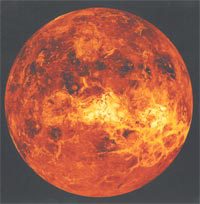 This planet is known by many poetic names: Venus, the Morning Star, the Evening Star… Unfortunately, through various explorations by space probes, humanity increasingly realizes that this star is not poetic at all; in fact, it is a hellish place.
This planet is known by many poetic names: Venus, the Morning Star, the Evening Star… Unfortunately, through various explorations by space probes, humanity increasingly realizes that this star is not poetic at all; in fact, it is a hellish place.
Upcoming, the European Space Agency will launch the Venus Express spacecraft to this planet with the hope of seeing the true face of the goddess Venus beneath its thick atmosphere at altitudes of 20-35 km.
On this occasion, the Planetary Society, headquartered in California (USA) – the largest non-governmental organization promoting space research in the world – has launched a drawing competition titled “Postcards from Venus” for everyone on Earth. The competition requires participants to imagine and draw “landscape pictures” of Venus from a bird’s-eye view. The top prize of the competition is a trip to the European Space Operations Centre in Darmstadt, Germany, in April next year, to observe the Venus Express spacecraft entering the orbit of this planet.
However, many believe that this competition has become outdated… by 40 years. The era when people still held a romantic and poetic view of Venus ended in the 1960s.
The Twin Brother
In its journey through the infinite universe, Venus is the closest planet to Earth, with similar size and mass. At night, it shines almost as brightly as the Moon. Classified as the most Earth-like planet in terms of geological composition, it is likely that no life could exist there, at least not in forms familiar to us on our green world.
Surrounded by a dense layer of carbon dioxide that is 90 times heavier than Earth’s atmosphere, Venus experiences a pressure of 92 bar – similar to that found 900 meters deep beneath the sea, where any normal submarine would be crushed like a matchbox. The temperature of 470°C prevents any drop of water from existing on its scorching surface, filled with pools of molten tin and lead resting on a hardened lava bed from erupting volcanoes. The concentration of sulfuric acid would incinerate any trace of living organisms.
For researchers, knowledge about Venus will allow for a better understanding of the history of the solar system and the future of Earth, as the extreme conditions that Venus has experienced reflect what we are still grappling with regarding the greenhouse effect and its impacts in the coming decades.
However, all knowledge about Venus until 1960 was based on indirect measurements using electromagnetic radar conducted by NASA’s Magellan probe from a near orbit, which represented objects larger than 100 meters.
Struggling to Recognize Relatives
On February 12, 1961, the Soviet satellite Venera 1 flew within 100,000 km of Venus but did not observe anything and lost contact with the control center due to high temperatures damaging its positioning sensors. The Americans had slightly more success with Mariner 2 a year later, which measured heat-emitting electromagnetic waves and confirmed that Venus has no magnetic field. Venera 2 caught fire before approaching Venus, and Venera 3 (1966) became the first envoy to reach the surface of this stormy planet, but was immediately destroyed. After Venera 5 and 6 were crushed by pressure at an altitude of 18 km, Venera 7 (1970) became the first successful landing, providing “real” images and accurate data on temperature and pressure, further refined by Venera 8 (1972). However, it wasn’t until Venera 16 (1982) that a complete geographical map of Venus was achieved…
 |
| Testing Venus Express in a vacuum environment |
Soon, Venus Express will be the pioneering flight of the European Space Agency to Venus. Covering 41 million km, in April 2006, Venus Express will enter a stable orbit to study the atmosphere and surface of Venus for two days (a day on Venus is nearly 500 Earth days!) and may extend for another two days if necessary. NASA’s Messenger spacecraft, on its way to Jupiter, also flew close to Venus in 2006 and 2007. The Japan Aerospace Exploration Agency (JAXA) also plans to launch the Planet C satellite in 2008. Expeditions to our twin brother will become bustling, as the Russians plan to launch a series of Venera D spacecraft in the next decade to continue the achievements of the past.
Now, the exploration spacecraft will not only tear through the cloud veil surrounding the Morning Star – Evening Star, but will also leave a steely aftertaste, making imagination increasingly less fertile…
See more articles: Postponed launch of the satellite to Venus

















































